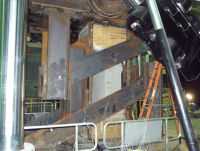Mining Topic: Seal Design
What is the health and safety problem?
The requirements for seal design were modified following the Sago Mine explosion, upgrading the design pressures from 20 to 120 psi for explosion-resistant performance. To accommodate this order of magnitude increase in capacity, significant changes in seal construction were required, particularly an increase in thickness to resist the higher blast pressures. Higher strength materials were also used. Unlike previous generations of seal designs, these have not been full-scale tested to verify their performance capability, and questions remain regarding the effects of installation and environmental factors on ultimate seal strength.
What is the extent of the problem?
The new generation of 120 psi explosion-proof seals and 50 psi intermediate seals, which require atmospheric monitoring , have been approved by MSHA and are now installed in all underground coal mines. Until the seal designs have been exposed to environmental conditions, ground pressures, aging, and ultimately explosion pressures, the adequacy of these designs will not be fully confirmed.
While these new seal designs certainly provide an increased level of performance, failure to perform at the rated design levels could be catastrophic. Full-scale testing of seals under either static or dynamic loading offers the most effective means to verify their strength levels. Using static testing, questions remain regarding the interpretation of static strength as a measure of ultimate performance capability.
How is the NIOSH Mining program addressing this problem?

Testing seal strength in OMSHR Safety Structure Testing Laboratory.
Research on seal design by the Office of Mine Safety and Health Research (OMSHR) aims to determine the adequacy of the new design explosion pressure standard and the degree of protection provided by seals that meet the new design regulations of 120 psi. OMSHR's two related research efforts are (1) to determine the worst-case explosion pressures that can result from methane gas explosions within the sealed area of coal mines, and (2) to determine the engineering adequacy of seal designs that have been approved to meet the new regulatory requirements.
To support these efforts, OMSHR constructed the Gas Explosion Test Facility at the Lake Lynn Laboratory for studying methane-air explosions and measuring the pressures that can develop. OMSHR also built the Seal Test Fixture for use in the Mine Roof Simulator for testing large-scale models of mine seals and measuring their engineering strength parameters.
What are the significant findings?
NIOSH performed methane-air explosion experiments to characterize the explosion processes that may occur in sealed areas of underground coal mines. Detonations, the most severe type of explosion which creates intensified pressures and propagation velocities, were initiated in mixtures containing between 5.3% and 15.5% methane in air.
Large-scale tests of approved coal mine seal designs made from plain concrete and reinforced concrete have been conducted in the Seal Test Fixture. This test rig is capable of applying a load of up to 240 psi over the entire face of a 4-foot-wide by 6-foot-high model seal. Preliminary analysis of test results suggests that plain concrete plugs about 8 to 10 feet thick and reinforced concrete seals about 3 to 4 feet thick are adequate to meet the new 120 psi coal mine seal design standard.
What are the next steps?
The laboratory tests will be completed and further recommendations made based on these results regarding the adequacy of current seal designs and how this information could be used in modeling of seal structures. Efforts will continue to secure a research partner to investigate atmospheric monitoring of sealed areas to explore how gases accumulate and the science of atmospheric dynamics that create explosive conditions.
See the NIOSH Mining Products page for software, guides, training materials or other items related to this topic.
See Also
- Compendium of Structural Testing Data for 20-psi Coal Mine Seals
- Composition Change Model for Sealed Atmosphere in Coal Mines
- Demonstration of Safety Plugging of Oil Wells Penetrating Appalachian Coal Mines
- Design and Analysis of a New Method to Test Mine Seals
- Explosion Pressure Design Criteria for New Seals in U.S. Coal Mines
- Explosion Pressure Design Criteria for Seals in U.S. Coal Mine - An Update on Work at NIOSH
- Methane-Air Detonation Experiments at NIOSH Lake Lynn Laboratory
- Progress Toward Improved Engineering of Seals and Sealed Areas of Coal Mines
- Refuge Alternatives in Underground Coal Mines
- Results of In-Mine Research in Support of the Investigation of the Sago Mine Explosion
- Structural Analysis and Design of Seals for Coal Mine Safety
- Wireless Mesh Mine Communication System
- Page last reviewed: 9/16/2012
- Page last updated: 9/22/2015
- Content source: National Institute for Occupational Safety and Health, Mining Program


 ShareCompartir
ShareCompartir